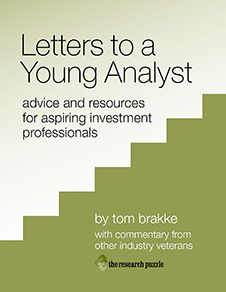
- Thursday, January 31st, 2013
- the odds boards
-
It is Super Bowl week, so thoughts turn to football, advertising, and wagering. Today we will consider the last of those three, specifically in regards to equity investing (as a part of this seriesthe research puzzle | The PDF index is updated at this URL whenever there’s a new posting.), although the same considerations apply to any kind of investing.
If you are betting on something, there’s an odds board that shows your chances, even if you can’t see it. At a racetrack, it’s easy to tell the long shots from the favorites by looking at the board. If you’re wagering on football, the line on the game includes some implicit odds. You can find out how the deck is stacked against you in blackjack depending on the rules of the house — and you can look up the odds for the lottery game you are playing.
What about your odds when buying a stock? It’s a multifaceted question, the answers to which will depend on the “security analysis religion”research puzzle pieces | My posting on the newest research puzzle blog about “pattern recognition” will give you the genesis of that phrase. to which you belong.
Let’s say the foundation of your approach is to assess a company’s position qualitatively. You judge its “moat” — the sustainability of its competitive advantage (if it has one) — and you evaluate the factors that will hurt its chances of success and those that will make it more likely. At some point, you boil it all down into a financial forecast, putting numbers to the factors and coming out with a map of the past and a model of the future.
But the stock is for sale at a price and you have to decide whether to buy it or to sell it. Enter valuation, which is nothing more than an odds board to help you think about that decision.
Recently I was at a meeting and a director of research (who also is an active analyst) said that he had come to the conclusion that valuation doesn’t matter. Basically his point was that fundamentals will win out and overwhelm any valuation structure. But that’s true for only a tiny fraction of very special companies (and we don’t know in advance which ones they will be).
All else being equal, the lower the valuation, the better your odds of success. That doesn’t mean that you are sure to lose when something is highly valued, rather that your likelihood of winning is lower or that the expectations of winning are baked in, so that you can lose even when the company wins.
There are many different valuation metrics. We could list them all, from the conservative, like normalized historical GAAP earnings, to those liberal interpretations of forward earnings minus whatever bits of unpleasantness analysts will agree to leave out of a company’s metrics. They can be based on dividends or enterprise value or (if you’ll remember) eyeballs.
The valuation odds board is electronic these days and you can see all of those ratios change second by second if you’d like. How to put them together into a decision framework is up to you, with the first choice you face being whether to go with the winds of relative valuation or to stick with some absolute standards.
But you’ll notice that the title of this posting is plural — there’s another odds board that many investors look at and quite a number of them rely on it almost completely. It doesn’t have an agreed-upon title like “valuation.” Some would call it “supply and demand” and some “investor behavior,” but we’re talking about signals related to price and other technical indicators.
The messages of the two boards often are in opposition to each other. It pays to know who you are, so that you stick to your methodology and don’t run back and forth to the board that gives you the most appealing read at any point in time. Or that if you use both boards (as many investors do), you do so in a disciplined and thoughtful way. Part of that is focusing on the much different time horizons that are implicit in the odds that you think you see.
So, how do you like your chances?
